- Your Government
-
Our Community
-
- About St. Helens History of St. HelensState of the CityCourthouse Dock Camera
- Local Events City Calendar Citizens Day in the ParkRecreation Activities Discover Columbia County Sand Island CampingKeep It Local CC
- Community Resources City Newsletter City Social Media Emergency Services New Resident InformationProtecting Our Environment
-
-
Business & Development
-
- Local Business Directory Get a Business License City Bids & RFPs Broadband Study
- Business in St. Helens St. Helens Advantages Directions & Transportation Incentives & Financing Resources for Businesses Business Guide Columbia Economic Team Chamber of Commerce
- Current City Projects Waterfront Redevelopment Public Safety Facility Strategic Work Plan
-
-
How Do I?
-
- Apply for a Job Apply for a Committee Find A Park Find COVID Info Find Forms Follow St. Helens - Facebook Follow St. Helens - Twitter Follow St. Helens - YouTube
- Get a Police Report Get a Business License Get a Library Card Get a Building Permit Newsletter Signup Past Public Meetings Pay My Water Bill
- Public Records Request Report a Nuisance Register for Rec Activity Reserve a Park Sign Up for the 911 Alerts Universal Fee Schedule
-
Membrane Maintenance
Membrane process modifications
This photo shows the modified end caps on the raw 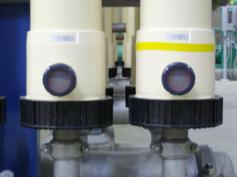 water feed
water feed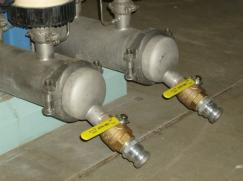 header. We welded a 2″ stainless steel by threaded nipple into the victaulic cap. To the threaded end we installed a 2″ ball valve with camloc adapters. These valves allow us to flush the mica and gypsum mud/silt from the main, rack feed headers. The photo on the right is the lower port of the PALL USV-6203 module that we use for flushing the mud/silt accumulation that is trapped in the modules.
header. We welded a 2″ stainless steel by threaded nipple into the victaulic cap. To the threaded end we installed a 2″ ball valve with camloc adapters. These valves allow us to flush the mica and gypsum mud/silt from the main, rack feed headers. The photo on the right is the lower port of the PALL USV-6203 module that we use for flushing the mud/silt accumulation that is trapped in the modules.
The Mud and Silt Problem
An ongoing problem that we experience at the St. Helens membrane filtration plant is a nuisance silt in our influent raw water. The gooey silt is made up of extremely fine Mica and Gypsum material that has made it’s way down through the layers of the various densities of mud, clay, sand and gravel making up the Columbia river bottom and into the laterals of the infiltration gallery of our Ranney collector system.
 The raw water entering the filtration plant appears to be crystal clear, however, when a sample of the clear water is collected in a glass bottle and held up to direct sunlight, now you can faintly see the very small, suspended flecks of the silt fines being illuminated by the bright sunlight, much like one can see tiny, tiny dust particles slowly floating in what appears to be crisp, clear air inside a room, that only the rays of bright sunshine flooding through a window into the room can reveal.
The raw water entering the filtration plant appears to be crystal clear, however, when a sample of the clear water is collected in a glass bottle and held up to direct sunlight, now you can faintly see the very small, suspended flecks of the silt fines being illuminated by the bright sunlight, much like one can see tiny, tiny dust particles slowly floating in what appears to be crisp, clear air inside a room, that only the rays of bright sunshine flooding through a window into the room can reveal.
Our nuisance mud/silt is carried along in the raw water right through the 113,000 gallon Raw water reservoir, the influent Raw water header, the Hayward 400 micron strainers and is deposited in the PALL Microfiltration influent header and up into the modules. (The Hayward strainer units would need to have a 30 to 50 micron screen to have any removal capability for this fine silt) As you can see in the picture at the lower left, the silt collects in the raw water feed header of the 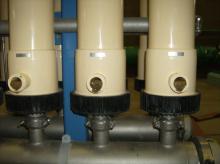 racks. The lower ports on the modules have an opaque lens on each of the individual modules. The opaque lens has become a valuable operational tool that allows us to monitor the silt accumulation and make informed decisions as to when we need to initiate our rack flushing procedure.
racks. The lower ports on the modules have an opaque lens on each of the individual modules. The opaque lens has become a valuable operational tool that allows us to monitor the silt accumulation and make informed decisions as to when we need to initiate our rack flushing procedure.
Modifying the Module Configuration on the BWR (backwash recovery) Rack
Originally, the 19 backwash recovery modules were installed on the dead-end portion of the raw water water header as seen in the picture on the left. To eliminate the “dead zone” in the header we moved the modules, air lines and CIP hoses, to the blanked off ports on the front or first section of the rack influent header (center picture). We then removed the upper and lower SS (stainless steel) headers and capped off the new short headers with the existing end caps.
We then fabricated the mobile flushing unit from one of the removed header sections.
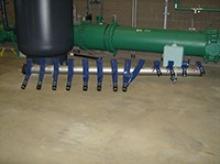
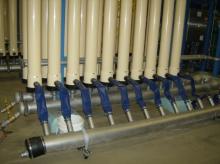
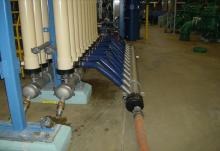
The Flushing Procedure
After isolating the rack, we attach a 3″ fire hose to one of the raw water header end cap valves. Open the 2″ quarter turn valve, manually operate the rack influent valve and flush the silt out of the feed header to waste. Close the influent valve, then switch the fire hose to the other feed header and flush it out the same way. With both of the feed headers being flushed of silt, we now direct our attention to the flushing of the silt from the rack modules. We remove the port caps from one side of the rack then attach the mobile flushing header (photo above) with the blue hoses to the open ports. Once again we manually operate the rack influent valve and we are now able to flush silt from the lower end of the modules through the lower ports out to waste. We wash the port caps and lenses, return them to the modules and move the flushing header to the other side of the rack and repeat the process.
This flushing procedure is allowing us to flush the entire raw water influent gallery, rack feed headers and the modules. We are seeing better IT results, maintaining a low TMP and we are helping extend the life of our Micro-filtration fibers. We flush the racks a minimum of every 3 months, however, rack 5, (which sees the backwash recovery water off the other 4 racks), we flush every month or when we see a mud/silt accumulation in the lower opaque sight glass of the port.
We welcome your suggestions, comments and questions.
![]()
Phone: 503-397-1311
503-397-1311
Go to the problem events we experienced when running Integrity tests

